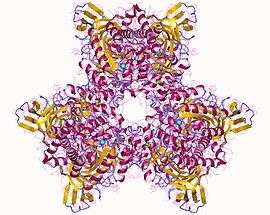Atrazine chlorohydrolase
| Atrazine chlorohydrolase | |||||||||
|---|---|---|---|---|---|---|---|---|---|
|
Atrazine chlorohydrolase hexamer, Pseudomonas sp. adp | |||||||||
| Identifiers | |||||||||
| EC number | 3.8.1.8 | ||||||||
| Databases | |||||||||
| IntEnz | IntEnz view | ||||||||
| BRENDA | BRENDA entry | ||||||||
| ExPASy | NiceZyme view | ||||||||
| KEGG | KEGG entry | ||||||||
| MetaCyc | metabolic pathway | ||||||||
| PRIAM | profile | ||||||||
| PDB structures | RCSB PDB PDBe PDBsum | ||||||||
| |||||||||
Atrazine Chlorohydrolase (AtzA) is an enzyme (E.C.3.8.1.8),[1] which catalyzes the conversion of atrazine to hydroxyatrazine. Bacterial degradation determines the environmental impact and efficacy of an herbicide or pesticide. Initially, most pesticides are highly effective and show minimal bacterial degradation; however, bacteria can rapidly evolve and gain the ability to metabolize potential nutrients in the environment. Despite a remarkable structural similarity, degradation of atrazine by bacteria capable of melamine degradation was rare; however, since its introduction as a pesticide in the United States, bacteria capable of atrazine degradation have evolved.[2] Currently, Pseudomonas sp. strain ADP seems to be the optimal bacterial strain for atrazine degradations, which appears to be the sole nitrogen source for the bacteria.[3]
Reaction
AtzA is an atrazine-dechlorinating enzyme with fairly restricted substrate specificity and plays a main role in the hydrolysis of atrazine to hydroxyatrazine in soils and groundwater.[3] Atrazine Hydroxyatrazine is a hydrolase (an enzyme that catalyzes the hydrolysis of a chemical bond ), which acts on halide bonds in C-halide compounds. In 1993, pseudomonas sp. strain ADP was shown to degrade atrazine to cyanuric acid via three steps, the first of which is a dechlorination.[2]
Genetics
De Souza, Sadowsky and Wackett were able to determine the nucleotide and amino acid sequence in 1996.[3] This enzyme is 98% identical in amino acid sequence, and subsequently in 3-D structure, to melamine deaminase but functionally different catalyzing the degradation of different substrates.[4] The gene coding for the enzyme shows 99% similarity between bacteria.[2] In fact there is only a 9-nucleotide difference, directly corresponding to the amino acid differences.[4] The nucleotide differences are unlikely to cause a conformational change in the enzyme but rather site-specific alterations.[4] This seems logical considering the remarkable similarity in the substrates and the relatively short period of evolution.
Specificity
AtzA was shown to displace fluoride as well as chlorine but not azido, cyano, methoxy, which are of similar size and electronegativity, or thiomethyl or amino groups.[2] The inability of AtzA to perform deamination makes it unique within its superfamily, amidohydrolases.[2] Furthermore, atrazine is not degraded by melamine deaminase and it does not inhibit melamine deaminase activity suggesting the active site is not specific for atrazine.[4]
References
- ↑ de Souza ML, Wackett LP, Boundy-Mills KL, Mandelbaum RT, Sadowsky MJ (September 1995). "Cloning, characterization, and expression of a gene region from Pseudomonas sp. strain ADP involved in the dechlorination of atrazine". Appl Environ Microbiol. 61 (9): 3373–8. PMC 167616
 . PMID 7574646.
. PMID 7574646.
UM-BBD reaction: From Atrazine to Hydroxyatrazine - 1 2 3 4 5 Seffernick JL, Johnson G, Sadowsky MJ, Wackett LP (October 2000). "Substrate specificity of atrazine chlorohydrolase and atrazine-catabolizing bacteria". Appl Environ Microbiol. 66 (10): 4247–52. doi:10.1128/AEM.66.10.4247-4252.2000. PMC 92292
 . PMID 11010866.
. PMID 11010866. - 1 2 3 de Souza ML, Sadowsky MJ, Wackett LP (August 1996). "Atrazine chlorohydrolase from Pseudomonas sp. strain ADP: gene sequence, enzyme purification, and protein characterization". J Bacteriol. 178 (16): 4894–900. PMC 178272
 . PMID 8759853.
. PMID 8759853.
- 1 2 3 4 Seffernick JL, de Souza ML, Sadowsky MJ, Wackett LP (April 2001). "Melamine deaminase and atrazine chlorohydrolase: 98 percent identical but functionally different". J Bacteriol. 183 (8): 2405–10. doi:10.1128/JB.183.8.2405-2410.2001. PMC 95154
 . PMID 11274097.
. PMID 11274097.
